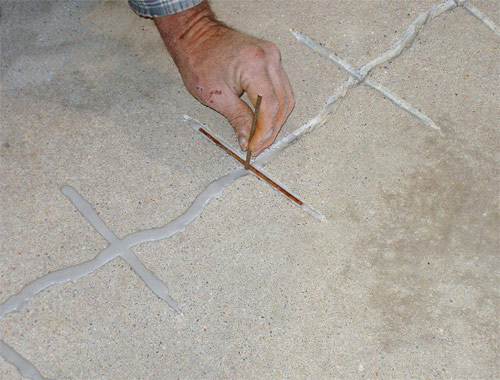

- CONCRETE SLAB CRACK REPAIR METHODS CRACKED
- CONCRETE SLAB CRACK REPAIR METHODS FULL
- CONCRETE SLAB CRACK REPAIR METHODS SERIES
Water blasting followed by a drying time may be effective in cleaning and preparing these cracks.Ĭores taken at cracks can be used to evaluate the effectiveness of the crack filling. If the cracks contain significant amounts of silt, moisture or other contaminants, the sealant cannot fill them. If surface friction is important, sand should be broadcast over the surface before the monomer or resin cures. Excess material should be broomed off the surface to prevent slick, shining areas after curing. the material should be worked back and forth over the cracks to obtain maximum filling since the monomer or resin recedes slowly into the cracks. The monomer or resin can be poured onto the surface and spread with brooms, rollers, or squeegees. Wet surfaces should be permitted to dry several days to obtain the best crack filling. The typical procedure is to clean the surface by air blasting and/or waterblasting. The lower the viscosity, the finer the cracks that can be filled. High-molecular-weight methacrylates, urethanes, and some low viscosity epoxies have been used successfully. Low viscosity monomers and resins can be used to seal cracks with surface widths of 0.03 to 2 mm by gravity filling. If the keying effect is essential, the resilient material can be placed in a second hole, the fiit being grouted. If water-tightness is essential and structural load transfer is not, the drilled hole should be filled with a resilient material of low modulus in lieu of grout. The key will also reduce heavy leakage through the crack and loss of soil from behind a leaking wall. The grout key prevents transverse movements of the sections of concrete adjacent to the crack. The drilled hole should then be cleaned, made tight, and filled with grout.
CONCRETE SLAB CRACK REPAIR METHODS FULL
The hole must be large enough to intersect the crack along its full length and provide enough repair material to structurally take the loads exerted on the key. This method is most often used to repair vertical cracks in retaining walls.Ī hole should be drilled, centered on and following the crack. This technique is only applicable when cracks run in reasonable straight lines and are accessible at one end. Figure 1: Repair of crack by drilling and plugging ⇒ Drilling and Pluggingĭrilling and plugging a crack consists of drilling down the length of the crack and grouting it to form a key ( Figure 1 ). This article includes Drilling and Plugging, Gravity Filling, Grouting and Drypacking.
CONCRETE SLAB CRACK REPAIR METHODS SERIES
On the other hand, if the cracks are due to a continuing foundation settlement, repair will be of no use until the settlement problem is corrected. In this series of articles under the title of “ Methods of Crack Repair in Concrete“, the different techniques applied to repair cracks are discussed. For example, if the cracking was primarily due to drying shrinkage, then it is likely that after a period of time the cracks will stabilize. Successful repair procedures take into account the cause(s) of the cracking.

CONCRETE SLAB CRACK REPAIR METHODS CRACKED
Following the evaluation of the cracked structure, a suitable repair procedure can be selected.


 0 kommentar(er)
0 kommentar(er)
